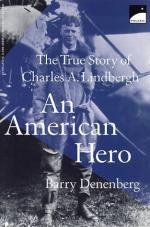|
This section contains 502 words (approx. 2 pages at 400 words per page) |

|
An American Hero: The True Story of Charles a. Lindbergh Summary & Study Guide Description
An American Hero: The True Story of Charles a. Lindbergh Summary & Study Guide includes comprehensive information and analysis to help you understand the book. This study guide contains the following sections:
This detailed literature summary also contains Topics for Discussion and a Free Quiz on An American Hero: The True Story of Charles a. Lindbergh by Barry Denenberg.
An American Hero is a biography of aviation pioneer Charles Lindbergh. Written for younger readers, the book covers the major events in Lindbergh's life, including his famous transatlantic flight and his controversial views about World War II.
Charles Lindbergh was born in 1902 to a politician father. His mother and father lived in separate residences and only refrained from divorcing to salvage the father's political career, so Lindbergh lived in a variety of places growing up. He enrolled in engineering school, but he never cared for school, and was instead interested in motorcycles, cars, airplanes, and other mechanical things.
Lindbergh quit college to take flying lessons in Nebraska. There, he became a barnstormer, flying around different communities and taking people for rides. He also performed tricks like wingwalking and acquired a reputation as a daredevil. He later joined the army, and impressed everyone with his flying skills.
In 1927, Lindbergh got financial backing from a businessman in order to build a plane, The Spirit of St. Louis, in a race to become the first man to fly across the Atlantic Ocean. Personally overseeing the plane, Lindbergh introduced several innovations into the design, and he was successful in a solo flight from New York to Paris. He became a worldwide celebrity and was mobbed wherever he went. He quickly developed a dislike for the media and constant attention. Around this time, he met and married Anne Morrow, daughter of a U.S. ambassador.
In 1932, tragedy struck when Lindbergh's infant son was stolen from his nursery. It was dubbed the "Crime of the Century", and it attracted nationwide attention. After a convoluted and botched investigation, the child's body was found two months later. The police traced gold certificates from the ransom money to a German immigrant named Bruno Hauptmann. Hauptmann was tried and found guilty of murder, and in 1936 he was electrocuted to death. Some modern historians have cast doubts as to whether Hauptmann was tried in a just fashion.
Throughout the 1930s, Lindbergh worked as a consultant for several new airline companies, and he helped to make aviation mainstream. In 1936, he was asked to make a visit to Nazi Germany to report on that country's military strength. Lindbergh was very impressed with Nazi Germany, and he felt the Germans were invincible. Lindbergh's adoration of Nazi Germany began to turn public perception against him, especially as World War II began. Lindbergh was a fierce supporter of an isolationist policy, and he argued that the United States should not enter World War II. Lindbergh was revealed to be an anti-Semite in a speech, and he became somewhat of a villain to most Americans, despite serving in several dozen combat missions over the Pacific.
After World War II, Lindbergh continued to fly around the world as a consultant for airlines. He wrote a best-selling autobiography and became involved with conservation causes. He died in 1974 of lymphatic cancer, and he never expressed regret over his controversial views on Nazi Germany or his white supremacist views.
Read more from the Study Guide
|
This section contains 502 words (approx. 2 pages at 400 words per page) |

|



